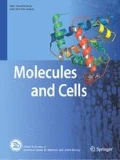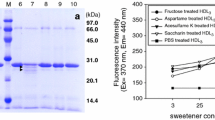Abstract
Long-term consumption of artificial sweeteners (AS) has been the recent focus of safety concerns. However, the potential risk of the AS in cardiovascular disease and lipoprotein metabolism has not been investigated sufficiently. We compared the influence of AS (aspartame, acesulfame K, and saccharin) and fructose in terms of functional and structural correlations of apolipoprotein (apo) A-I and high-density lipoproteins (HDL), which have atheroprotective effects. Long-term treatment of apoA-I with the sweetener at physiological concentration (3 mM for 168 h) resulted in loss of antioxidant and phospholipid binding activities with modification of secondary structure. The AS treated apoA-I exhibited proteolytic cleavage to produce 26 kDa-fragment. They showed pro-atherogenic properties in acetylated LDL phagocytosis of macrophages. Each sweetener alone or sweetener-treated apoA-I caused accelerated senescence in human dermal fibroblasts. These results suggest that long-term consumption of AS might accelerate atherosclerosis and senescence via impairment of function and structure of apoA-I and HDL.
Similar content being viewed by others
References
Benzie, I.F., and Strain, J.J. (1996). The ferric reducing ability of plasma (FRAP) as a measure of antioxidant power: the FRAP assay. Anal. Biochem. 239, 70–76.
Brewer, H.B. Jr., Ronan, R., Meng, M., and Bishop, C. (1986). Isolation and characterization of apolipoprotein A-I, A-II, and A-IV. Methods Enzymol. 128, 223–246.
Chen, Y.H., Yang, J.T., and Martinez, H.M. (1972). Determination of the secondary structures of proteins by circular dichroism and optical rotatory dispersion. Biochemistry 11, 4120–4131.
Cho, K.H. (2009a). Biomedicinal implications of high-density lipoprotein: its composition, structure, functions, and clinical applications. BMB Rep. 42, 393–400.
Cho, K.H. (2009b). Synthesis of reconstituted high-density lipoprotein (rHDL) containing apoA-I and apoC-III: the functional role of apoC-III in rHDL. Mol. Cells 27, 291–297.
Cho, K.H., Park, S.H., Han, J.M., Kim, H.C., Choi, Y.K., and Choi, I. (2006). ApoA-I mutants V156K and R173C promote anti-inflammatory function and antioxidant activities. Eur. J. Clin. Invest. 36, 875–882.
Cho, K.H., Park, S.H., Han, J.M., Kim, H.C., Chung, Y.J., Choi, I., and Kim, J.R. (2007). A point mutant of apolipoprotein A-I, V156K, exhibited potent anti-oxidant and anti-atherosclerotic activity in hypercholesterolemic C57BL/6 mice. Exp. Mol. Med. 39, 160–169.
DeGarmo, O., Ashworth, G.W., Eaker, C.M., and Munch, R.H. (1952) Hydrolytic stability of saccharin. J. Am. Pharm. Assoc. Am. Pharm. Assoc. 41, 17–18.
Dimri, G.P., Lee, X., Basile, G., Acosta, M., Scott, G., Roskelley, C., Medrano, E.E., Linskens, M., Rubelj, I., Pereira-Smith, O., et al. (1995). A biomarker that identifies senescent human cells in culture and in aging skin in vivo. Proc. Natl. Acad. Sci. USA 92, 9363–9367.
Eberini, I., Calabresi, L., Wait, R., Tedeschi, G., Pirillo, A., Puglisi, L., Sirtori, C.R., and Gianazza, E. (2002). Macrophage metalloproteinases degrade high-density-lipoprotein-associated apolipoprotein A-I at both the N- and C-termini. Biochem. J. 362, 627–634.
Eberini, I., Gianazza, E., Breghi, L., Klugmann, S., Calabresi, L., Gomaraschi, M., Mombelli, G., Brusoni, B., Wait, R., and Sirtori, C.R. (2007). Apolipoprotein A-I breakdown is induced by thrombolysis in coronary patients. Ann. Med. 39, 306–311.
Esterbauer, H., Striegl, G., Puhl, H., and Rotheneder, M. (1989). Continuous monitoring of in vitro oxidation of human low density lipoprotein. Free Radic. Res. Commun. 6, 67–75.
Feng, H., and Li, X.A. (2009). Dysfunctional high-density lipoprotein. Curr. Opin. Endocrinol. Diabetes Obes. 16, 156–162.
Fraenkal-Conrat, H. (1957). Methods for investigating essential groups for enzyme activity. Meth. Enzymol. 4, 247–269.
Jaleel, A., Henderson, G.C., Madden, B.J., Klaus, K.A., Morse, D.M., Gopala, S., and Nair, K.S. (2010). Identification of de novo synthesized and relatively older proteins: accelerated oxidative damage to de novo synthesized apolipoprotein A-1 in type 1 diabetes. Diabetes 59, 2366–2374.
Ji, Y., and Jonas, A. (1995). Properties of an N-terminal proteolytic fragment of apolipoprotein AI in solution and in reconstituted high density lipoproteins. J. Biol. Chem. 270, 11290–11297.
Liz, M.A., Gomes, C.M., Saraiva, M.J., and Sousa, M.M. (2007). ApoA-I cleaved by transthyretin has reduced ability to promote cholesterol efflux and increased amyloidogenicity. J. Lipid Res. 48, 2385–2395.
Markwell, M.A., Haas, S.M., Bieber, L.L., and Tolbert, N.E. (1978). A modification of the Lowry procedure to simplify protein determination in membrane and lipoprotein samples. Anal. Biochem. 87, 206–210.
McPherson, J.D., Shilton, B.H., and Walton, D.J. (1988). Role of fructose in glycation and cross-linking of proteins. Biochemistry 27, 1901–1907.
Mukherjee, A., and Chakrabarti, J. (1997). In vivo cytogenetic studies on mice exposed to acesulfame-K-a non-nutritive sweetener. Food Chem. Toxicol. 35, 1177–1179.
Nofer, J.R., Walter, M., and Assmann, G. (2005). Current understanding of the role of high-density lipoproteins in atherosclerosis and senescence. Expert Rev. Cardiovasc. Ther. 3, 1071–1086.
Odegaard, A.O., Koh, W.P., Arakawa, K., Yu, M.C., and Pereira, M.A. (2010). Soft drink and juice consumption and risk of physician-diagnosed incident type 2 diabetes: the Singapore Chinese Health Study. Am. J. Epidemiol. 171, 701–708.
Oliveira-da-Silva, A., Vieira, F.B., Cristina-Rodrigues, F., Filgueiras, C.C., Manhães, A.C., and Abreu-Villaça, Y. (2009). Increased apoptosis and reduced neuronal and glial densities in the hippocampus due to nicotine and ethanol exposure in adolescent mice. Int. J. Dev. Neurosci. 27, 539–548.
Olney, J.W., Farber, N.B., Spitznagel, E., and Robins, L.N. (1996). Increasing brain tumor rates: is there a link to aspartame? J. Neuropathol. Exp. Neurol. 55, 1115–1123.
Park, K.H., and Cho, K.H. (2011) High-density lipoproteins (HDL) from elderly and reconstituted HDL containing glycated apolipoproteins A-I share pro-atherosclerotic and pro-senescent properties with increased cholesterol influx. J. Gerontol. A. Biol. Sci. Med. Sci. 66, 511–520.
Park, K.H., Jang, W., Kim, K.Y., Kim, J.R., and Cho, K.H. (2010a). Fructated apolipoprotein A-I showed severe structural modification and loss of beneficial functions in lipid-free and lipid-bound state with acceleration of atherosclerosis and senescence. Biochem. Biophys. Res. Commun. 392, 295–300.
Park, K.H., Shin, D.G., Kim, J.R., and Cho, K.H. (2010b). Senescence-related truncation and multimerization of apolipoprotein AI in high-density lipoprotein with an elevated level of advanced glycated end products and cholesteryl ester transfer activity. J. Gerontol. A Biol. Sci. Med. Sci. 65, 600–610.
Park, K.H., Yun, C.O., Kwon, O.J., Kim, C.H., Kim, J.R., and Cho, K.H. (2010c). Enhanced delivery of an adenovirus using proteoliposomes containing WT or V156K apolipoproteinA-I and dimyristoylphosphatidylcholine. Hum. Gene Ther. 21, 579–587.
Pownall, H.J., Massey, J.B., Kusserow, S.K., and Gotto, A.M. Jr. (1978). Kinetics of lipid-protein interactions: interaction of apolipoprotein A-I from human plasma high density lipoproteins with phosphatidylcholines. Biochemistry 17, 1183–1188.
Reuber, M.D. (1978). Carcinogenicity of saccharin. Environ. Health Perspect 25, 173–200.
Rye, K.A., and Barter, P.J. (2008). Antiinflammatory actions of HDL: a new insight. Arterioscler. Thromb. Vasc. Biol. 28, 1890–1891.
Sasaki, Y.F., Kawaguchi, S., Kamaya, A., Ohshita, M., Kabasawa, K., Iwama, K., Taniguchi, K., and Tsuda, S. (2002) The comet assay with 8 mouse organs: results with 39 currently used food additives. Mutat. Res. 519, 103–119.
Scarmeas, N. (2007). Invited commentary: lipoproteins and dementia — Is it the apolipoprotein A-I? Am. J. Epidemiol. 165, 993–997.
Seo, S.J., Park, K.H., and Cho, K.H. (2008). Apolipophorin III from Hyphantria cunea shows different anti-oxidant ability against LDL oxidation in the lipid-free and lipid-bound state. Comp. Biochem. Physiol. B Biochem. Mol. Biol. 151, 433–439.
Staros, J.V. (1982). N-hydroxysulfosuccinimide active esters: bis(Nhydroxy-sulfosuccinimide) esters of two dicarboxylic acids are hydrophilic, membrane-impermeant, protein cross-linkers. Biochemistry 21, 3950–3955.
Upmeier, E., Lavonius, S., Lehtonen, A., Viitanen, M., Isoaho, H., and Arve, S. (2009). Serum lipids and their association with mortality in the elderly: a prospective cohort study. Aging Clin. Exp. Res. 21, 424–430.
Van den Eeden, S.K., Koepsell, T.D., Longstreth, W.T. Jr., van Belle, G., Daling, J.R., and McKnight, B. (1994). Aspartame ingestion and headaches: a randomized crossover trial. Neurology 44, 1787–1793.
Walter, M. (2009). Interrelationships among HDL metabolism, aging, and atherosclerosis. Arterioscler. Thromb. Vasc. Biol. 29, 1244–1250.
Weihrauch, M.R., and Diehl, V. (2004). Artificial sweeteners-do they bear a carcinogenic risk? Ann. Oncol. 15, 1460–1465.
Zeng, R.Z., Kim, H.G., Kim, N.R., Lee, H.Y., Jung, B.J., Ko, M.Y., Lee, S.Y., and Chung, D.K. (2010). Protein expression changes in human monocytic THP-1 cells treated with lipoteichoic acid from Lactobacillus plantarum and Staphylococcus aureus. Mol. Cells 29, 585–594
Author information
Authors and Affiliations
Corresponding author
Additional information
These authors contributed equally to this work.
About this article
Cite this article
Jang, W., Jeoung, N.H. & Cho, KH. Modified apolipoprotein (apo) A-I by artificial sweetener causes severe premature cellular senescence and atherosclerosis with impairment of functional and structural properties of apoA-I in lipid-free and lipid-bound state. Mol Cells 31, 461–470 (2011). https://doi.org/10.1007/s10059-011-1009-3
Received:
Revised:
Accepted:
Published:
Issue Date:
DOI: https://doi.org/10.1007/s10059-011-1009-3




